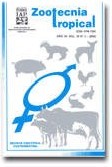
|
Zootecnia Tropical
Instituto Nacional de Investigaciones Agrícolas Venezuela
ISSN: 0798-7269
Vol. 29, No. 3, 2011, pp. 255-260
|
 Bioline Code: zt11023
Bioline Code: zt11023
Full paper language: English
Document type: Research Article
Document available free of charge
|
|
|
Zootecnia Tropical, Vol. 29, No. 3, 2011, pp. 255-260
| en |
Strategies to increase the production of beef of hair sheep from the Huasteca Potosina, Mexico
Magaña, Humberto Lucero; Encinia, Florencio Briones; Magaña, Froylán Andrés Lucero; Meléndez, Javier Hernández; Rodríguez, Sonia Patricia Castillo & González, Juan Carlos Martínez
Abstract
The objective of the study was to evaluated the birth (BW) and weaning weights (WW) of Blackbelly (BB)
lambs and its Katahdin crosses (KK) x BB (KB) in a fl ock kept under grazing conditions and supplementation
from Huasteca Potosina. The work was carried out in the “Barrancon” farm located at Tanlajas, San Luis Potosi,
Mexico. The climate is classified as warm sub-humid with an average precipitation and annual temperature of
1,678.5 mm and 24.5°C, respectively. The farm has padlock of Cynodon dactylon

and Cynodon nlemfuensis

.
One hundred BB ewes were used, with an average weight of 23 kg, with two KK and two BB males. They were
assigned to a 2 (feeding) by 2 (parental breed) factorial arrangements. The feeding types were single grazing, and
grazing plus 250 grams of protein supplementation, and the parental breeds were BB and KK. The lambs were
weighed at born and weaning in a roman scale. Analysis of variance was carried out by least square methods.
The averages at BW and WW were 2.74 ± 0.74 and 11.4 ± 0.4 kg, respectively. The breed affected only the birth
weight (P<0.01) with the lambs sired by KK weighting 11.2% more than the BB’s ones. The lambs that received supplementation weighed 16.4% more at weaning, while the KB sired lambs were 1.4% heavier than BB’s at
weaning (P>0.05). It is concluded that BB produce heavier lambs at birth, but further analysis need to be carried
out to study the economic and sheep production system implication under the conditions of the present trail.
hair sheep, birth weight, weaning weight, supplementation.
|
| |
| es |
Estrategias para incrementar la producción de carne de ovinos de pelo en la Huasteca Potosina, México
Magaña, Humberto Lucero; Encinia, Florencio Briones; Magaña, Froylán Andrés Lucero; Meléndez, Javier Hernández; Rodríguez, Sonia Patricia Castillo & González, Juan Carlos Martínez
Resumen
El objetivo del presente estudio fue evaluar el peso al nacer (PN) y al destete (PD) de corderos Blackbelly (BB)
y cruzados Katahdin x BB (KB) en un rebaño mantenido bajo condiciones de pastoreo y suplementación en la
Huasteca Potosina. El trabajo se realizó en la finca “Barrancón” municipio de Tanlajás, San Luis Potosí, México.
El clima está clasificado como cálido subhúmedo con una precipitación y temperatura media anual de 1.678,5
mm y 24,5°C, respectivamente. La fi nca cuenta con praderas de Cynodon dactylon

y Cynodon nlemfuensis

, se
utilizaron 100 borregas primalas BB, con un peso promedio de 23 kg, dos machos KK y dos BB. Las borregas
fueron asignadas a dos tipos de alimentación (solo pastoreo y pastoreo + suplementación de 250 g de concentrado)
y a machos de dos razas (KK y BB). Las crías se pesaron al nacer y al destete en una báscula romana, las variables
de PN y PD fueron estudiadas por medio de un análisis de varianza para un diseño completamente al azar con
arreglo factorial 2 x 2. Las medias de PN y PD fueron 2,74 ± 0,74 y 11,4 ± 0,4 kg, respectivamente. La raza del
semental solo afectó (P<0,01) el PN. Las crías de machos KK pesaron 11,2% más que las de BB. Los corderos de
ovejas que recibieron suplementación pesaron 16,4% más al destete, mientras que los corderos KB fueron 1,4%
más pesados al destete, sin que estas diferencias fueran significativas (P>0,05). Se concluye que es necesario
evaluar al sistema de producción en su conjunto para determinar el impacto económico de la introducción de
razas mejoradas y el nivel de suplementación.
ovinos de pelo, peso al nacer, peso al destete, suplementación.
|
| |
© Copyright 2011 - Zootecnia Tropical
Alternative site location: http://www.sian.inia.gob.ve/repositorio/revistas_ci/ZootecniaTropical/ztindice.htm
|
|
